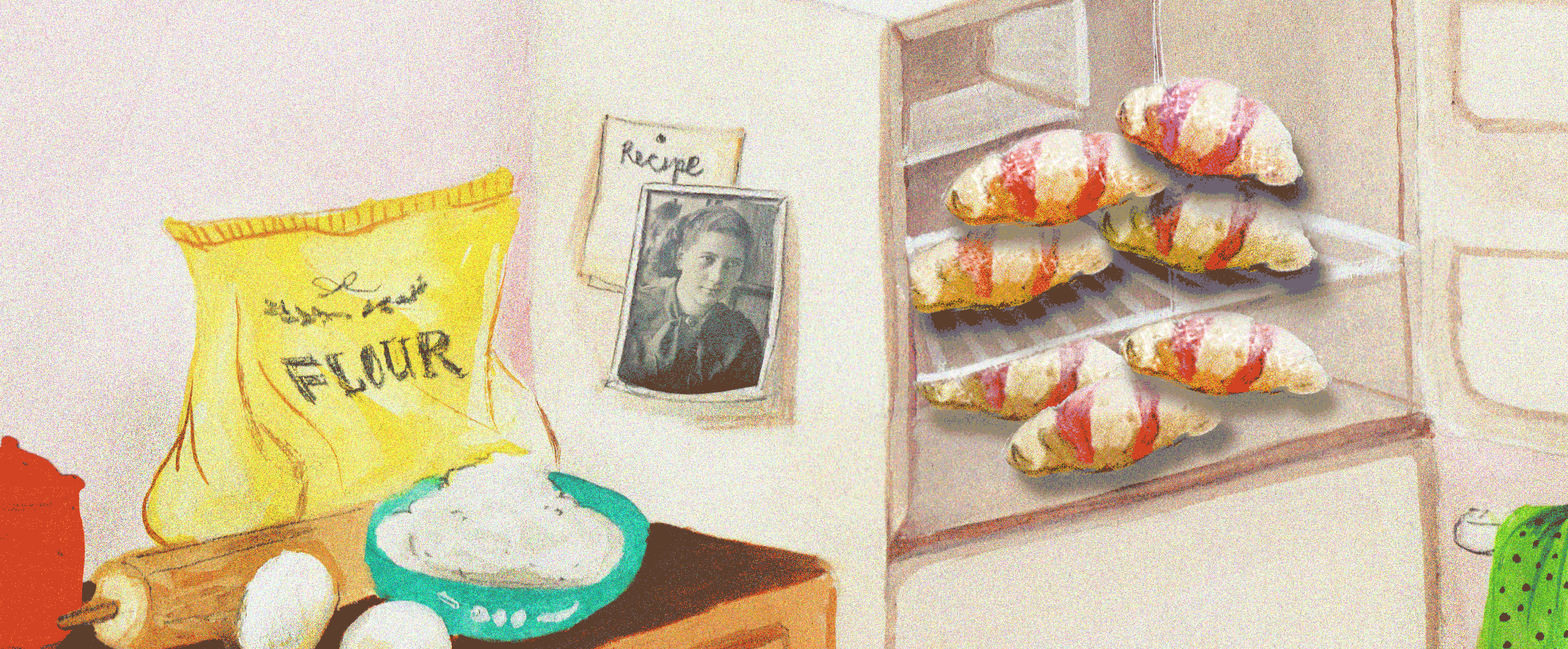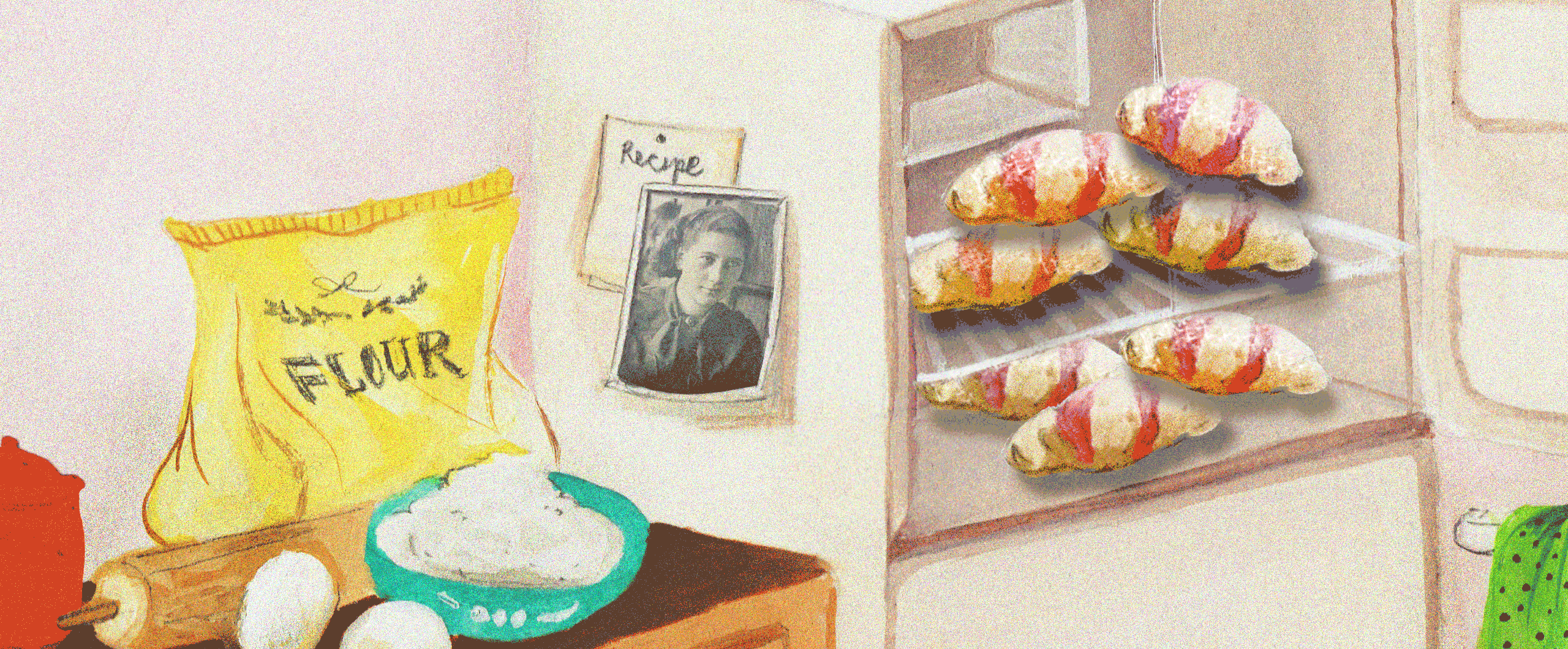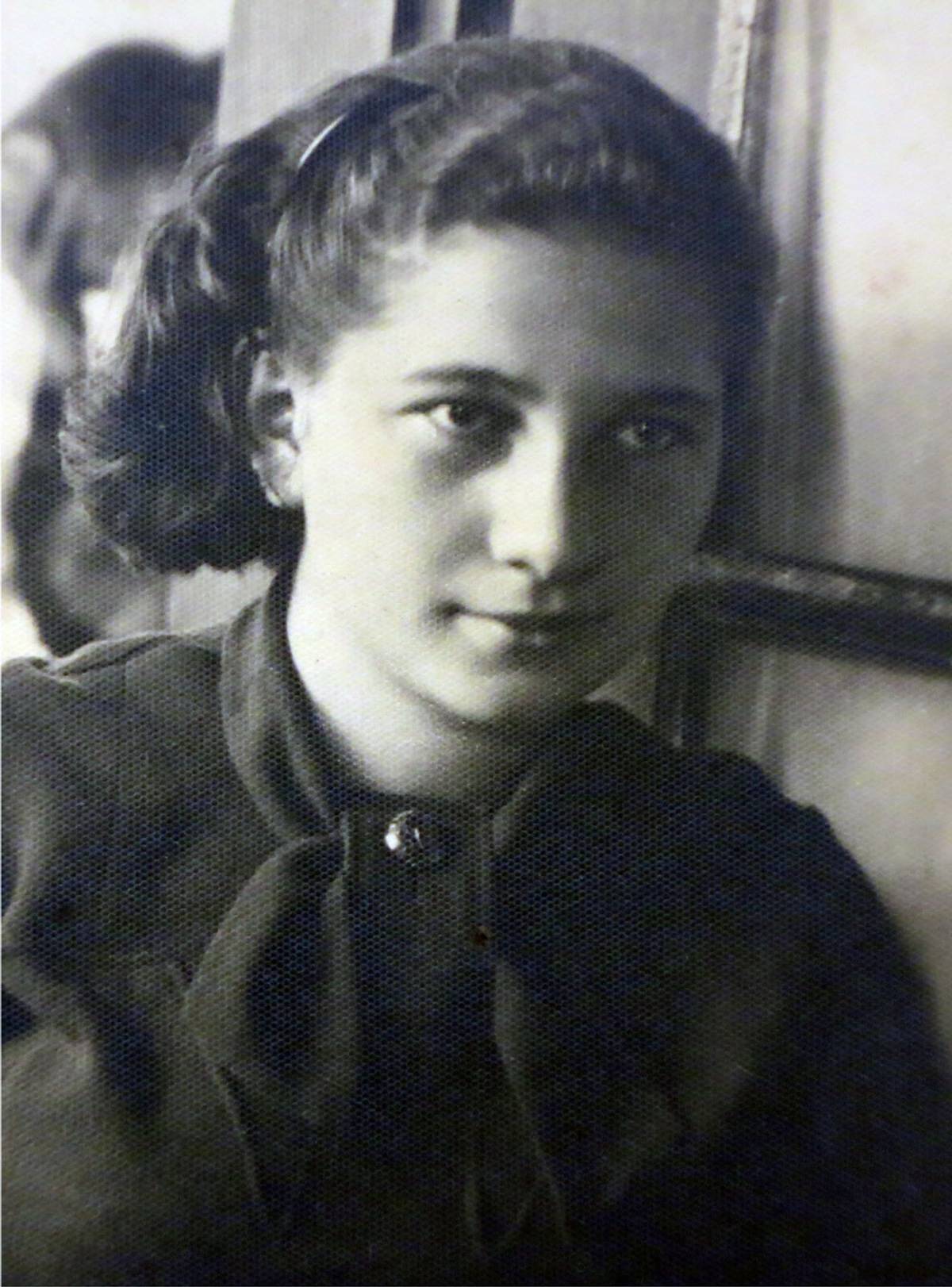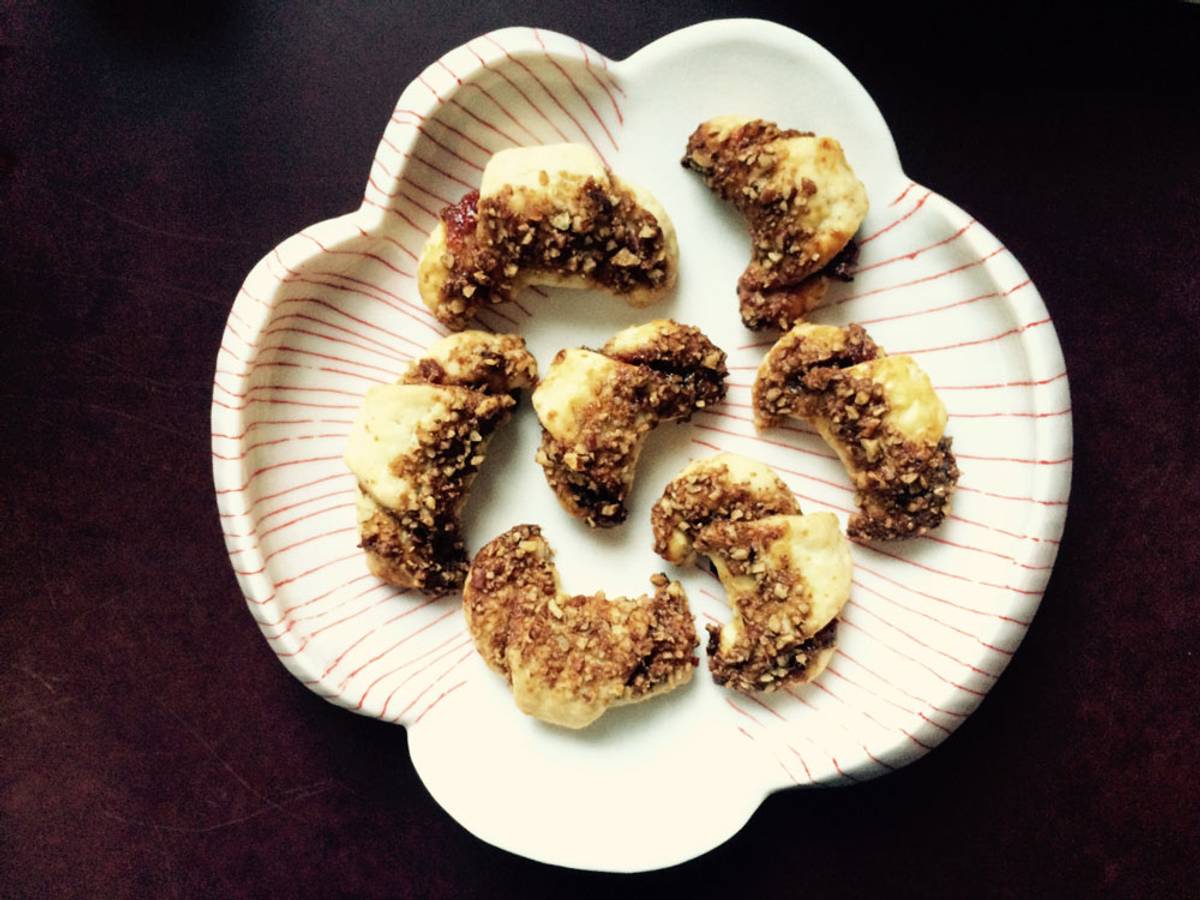Inspiration in the Form of an Empty Freezer
Baking my grandmother’s rugelach helps me hold on to her—and pass on her memory to the next generation




My grandmother fled Poland in 1938 when she was 19 years old, bound for Cuba, where she and her mother and sister would spend two years before immigrating to the United States. She didn’t bring much with her from Poland, but she did bring recipes. Whether it was her chopped liver or her blintzes, her gefilte fish (from scratch) or her carrot ring, she brought the flavors of her old home to her new home.
She also baked—desserts from Europe, as well as purely American ones she mastered after she arrived. There were cheesecakes and pound cakes and rum balls to beat the band, but there were five standbys that she made the most: chocolate chip cookies, macaroons, banana cake with chocolate chips, “chocolate bar cake,” and rugelach.

Each of my grandmother’s children and grandchildren had their favorites, and she never wanted to be without someone’s dessert of choice, so she produced in quantity: Her freezer was full of aluminum-foil-wrapped, plastic-bagged baked goods. Whenever she came to visit she would bring a little something. “In case you have company,” she would say, stuffing another bag into our freezer with the rest. It became a nuisance and a joke. We’d open our freezer for a bag of peas, and a few of her frozen Bundt cakes would inevitably topple out. “More bar cake!” we would exclaim, opening another cold, silver package. No matter how well my grandmother’s baked goods had been wrapped, the taste always included a touch of freezer burn. But we still ate them.Her cakes and cookies were always the same, which left us wishing for something different, something new—until she died in 2012, at which point the last of the chocolate bar cake, the last of the cookies, became something rare and beautiful. They sat in my mother’s freezer drawer untouched. No one made fun anymore when a silver brick of baked goods fell out on their foot. These cookies were the last we would ever have made by my grandmother’s hands.
A year after my grandmother’s death, my parents sold their house of 30 years, and my mother realized she could not transport my grandmother’s cookies from one freezer to another. So, we ate the last of them. And then there were no more. Even though we had her recipes, nobody else in the family baked any of her famous desserts. Maybe no one craved chocolate bar cake—we’d eaten enough of it to be satiated for a lifetime. Or maybe nobody wanted to try to fill her shoes.
But last Mother’s Day, some relatives were coming over for tea. Unlike my grandmother, I didn’t have a stockpile of treats from my freezer to serve. So, I opened her recipe book and made the chocolate bar cake myself. A simple shortbread-type cookie base layered with chocolate chips and a nut topping, it was quick and easy and completely delightful. As I shared the sweet squares with my family, I was struck by how much more delicious they were when they were fresh from the oven, rather than not-so-fresh from the freezer. I made them again, this time swapping out some of the white flour for whole wheat and some of the walnuts for pecans—superb!
Soon after that, I turned the page in my grandmother’s recipe book: banana cake. This recipe called for sour cream, a substance to which my husband has an extreme aversion. But I had a few old bananas, and my 4-year-old son loves anything with chocolate chips. So we got out the bowls and flour, butter, and eggs. My son brought a chair from the dining room and stood next to me at the kitchen counter. He did the scooping. I cracked the eggs. I used low-fat sour cream and coconut sugar instead of refined, but the result was just as moist and flavorful as my grandmother’s cake.
The next two pages I skipped: Chocolate chip cookies are already a standby in our house, and I’ve made them enough times to not need my grandmother’s recipe. Her macaroons I never actually liked, the recipe coming from a can of almond paste popular at the time. But then came the rugelach—a cookie that had grown on me over the years. These were, without a doubt, the most culturally significant and beloved tastes of my grandmother’s fare. What I noticed when I was young was how all the grown-ups reacted to the rugelach: Of all the desserts my grandmother churned out, the rugelach never failed to garner reactions of amazement and something close to rapture. Whatever disagreements the family might have, whatever familial tension in the room, no one ever argued about the rugelach. It was the cookie of peace. As I got older and tasted rugelach from other kitchens and bakeries, I started to realize what a gift my grandmother had. While a store-bought rugelach has little texture or taste, rugelach from my grandmother’s kitchen had the perfect mix of sweet and spice, flake and crunch.
I tried to make rugelach from my grandmother’s recipe once and failed, but after that first attempt, I’d learned a few things about working with dough from my pie-baker friend, Kate. Good rugelach, like a good pie, must be made by hand with a delicate touch. The dough and the filling are of equal importance. The dough must not be overworked, or else it will lose its lightness; the filling should taste divine all on its own, before it is baked into anything. Putting the two together will yield excellent results—if you remember a few key details: When making the dough, the ingredients need to be nice and warm. When rolling the dough out, it should be plenty cold—keeping the balls of dough in the fridge until the exact moment they are needed is key. Whacking the balls down with the end of a rolling pin until they are flat discs makes for a more consistent roll-out with far less handling of the dough. The less handling, the more flake.

Keeping Kate’s suggestions in mind, I tried again to make my grandmother’s rugelach. This time, when I opened my fridge for ingredients, I saw the red plum jam Kate had just made for me. The plums had come from our Japanese plum tree, and they were the sweetest, most delicious plums we’d ever eaten. The resulting jam was heavenly. My grandmother had always preferred apricot jam, but in a pinch she would use whatever she had on hand, which gave me the freedom to do the same. I didn’t have apricot jam in the pantry, so I took the plum. My new skills and the excellent jam matched up beautifully. My rugelach turned out subtle, flaky, and not completely misshapen. They reminded me very much of my grandmother’s rugelach, and yet with my little modifications (recipe here) they became completely my own.
I was the eldest of my grandmother’s six grandchildren, and I spent the most time with her, since we lived close by. While her children often chided her for spending too much time in the kitchen, I never faulted her for it. She took care of me for many years when my mother was single and needed help. Sitting at her kitchen table, she would tell me about her friends, her travels, her memories. When she was very old, she told me more than once that she felt I knew her better than anyone.
Since she died, I have tried to hold on to her by keeping some of her traditions: planting marigolds in the garden, squeezing orange juice fresh in the morning, wrapping my son in towels like a blintz after he bathes, lighting an extra Yahrzeit candle at holidays for those who have no one else to light one for them. And now, baking. I always wanted to record her voice on tape so that I would never forget the sound of it, and so I could play it for my son—but I never did, and my grandmother died when he was just a year old. So, baking isn’t just how I hold on to her; it’s also how I make sure my son gets to know her just a little: I show him how to scoop the flour, baking soda, baking powder. I show him how to mix the wet ingredients into the dry.
Together we have put my grandmother’s recipes back into heavy rotation. This week, my son and I have been eating banana cake for a snack every morning. Last week, I cut chocolate bar cake into thin slices and took it to the neighborhood block party down the street. I packed up a little bag of rugelach for my friend’s 40th birthday, and another to welcome a friend who just moved back to town. With each gesture, my grandmother is with us. This nourishing legacy is what I have left of her, and this is what I will pass on.
***
Like this article? Sign up for our Daily Digest to get Tablet Magazine’s new content in your inbox each morning.
Margot Kahn is a writer-in-residence with Seattle Arts & Lectures and the author of the biography Horses That Buck: The Story of Champion Bronc Rider Bill Smith.
Plum Pecan Rugelach
Anna Zylberberg’s recipe adapted by Margot Kahn
1 8-ounce package cream cheese, softened
2 sticks unsalted butter, softened
2 cups unbleached white flour
4 ounces (approximately) red plum jam (see recipe below)
1 cup ground pecans
1/2 cup coconut sugar
1/4 teaspoon cinnamon
1/4 teaspoon cardamom
1 egg white
For the dough, mash the cream cheese and butter together until thoroughly blended. If ingredients are sufficiently soft, this can be done with a whisk, wooden spoon, or fork. Mix in the flour. Dust your hands with flour and make the dough into a roll. Cut the roll into 4 pieces, wrap in plastic, and refrigerate overnight.
Preheat oven to 350 and grease two baking sheets.
In small bowl, combine ground nuts, sugar, cinnamon and cardamom. In a separate bowl, beat one egg white until frothy.
On a floured countertop, whack one ball of dough with a rolling pin until it is flattened a bit and then roll out to a 10-inch disc. About an inch from the outer edge of the disc, spread a couple tablespoons of jam. Your disc should look like a target: an inner bullseye of plain dough, then a ring of jam, then the outer ring of plain dough. Sprinkle a generous amount of nut mixture over the jam.
Cut the disc into 8 wedges, like a pizza. Working quickly, roll each wedge from the outside in. Bend the roll into a crescent shape. Dip the top of the cookie into the egg mixture and then into the nut mixture. Place cookies on the baking sheet about an inch apart, making sure the pointy end of the dough is tucked under the cookie.
Bake 25-30 minutes, or until golden. Remove from the sheet immediately and cool on a rack.
Yield: 32 cookies.
***
Red Plum Jam
Recipe by Kate Lebo
6 cups sweet red plums (about 6 plums a cup, about 36 plums total)
3 cups sugar
2 Tbsp lemon juice
1 small shredded baking apple (with peel, without core)
Macerate plums in sugar and lemon juice overnight.
When ready to jam, sterilize five 8-ounce jars and lids.
Strain the juice from the cut fruit and pour into a heavy-bottomed stainless steel pan. Set the fruit aside for now. Simmer the juice on medium heat for 10-15 minutes until slightly syrupy. As it simmers, strain and discard any foam.
Once the liquid has thickened slightly, add the plums and shredded apple to the pot.
Boil on medium heat, stirring the whole time, 15 minutes, or until the jam bubbles thickly and starts to splatter you and your oven. Check the set by scooping some with your spoon and watching it drip back into the pot. If the drips are quick and thin, it’s not done. If the drips are thick and slow and don’t immediately fall off the spoon, it’s done.
Spoon the jam into jars, process for 10 minutes, and let cool. This jam needs only half a day to reach a firm set.
Yield: about 40 ounces of jam
Margot Kahn is a writer-in-residence with Seattle Arts & Lectures and the author of the biographyHorses That Buck: The Story of Champion Bronc Rider Bill Smith.